DDoS (Distributed Denial of Service) attacks have surged dramatically in 2025,1 with industry reports showing a year-over-year increase of more than 350% in the first quarter alone. These large-scale assaults flood websites, applications, or networks with malicious traffic, leading to outages, frustrated customers, and costly downtime.
While stopping DDoS attacks entirely is challenging, you can take proven steps to reduce your risk. In this guide, you’ll learn what a DDoS attack is, the most common types of DDoS attacks, and 10 best practices on how to stop them to protect your organization.
What Is A DDoS Attack & What It Does To Your Business
During a Distributed Denial of Service (DDoS) attack, hackers attempt to disrupt a web server, application, or network by overwhelming it with internet traffic. Unlike a Denial of Service (DoS) attack, which originates from a single source, modern DDoS attacks use multiple compromised systems as sources of attack traffic.
The primary goal of a DDoS attack is to disable a website or online service. Legitimate users can’t access the service, leading to potential financial losses, reputational damage, and customer frustration.
How Do DDoS Attacks Work? 4 Common Types
DDoS attacks exploit the fundamental principles of network communication. Attackers use a botnet, which is a network of multiple compromised computer systems, to send a huge amount of traffic to the target. Botnets can be made up of thousands or even millions of infected devices, each of which contributes to the attack without the knowledge of their owners.
The attack process begins with recruitment, which involves the attacker infecting vulnerable devices with malware to build a botnet. They configure the botnet to target a specific victim, and the botnet floods the target with malicious traffic to overwhelm its resources.
The most common types of DDoS attacks are:
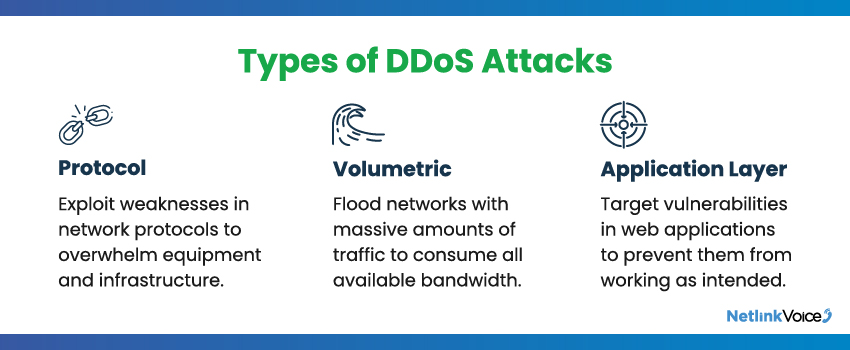
Protocol Attacks
Protocol attacks, also known as infrastructure-layer attacks, target the protocols used in data transfers to overwhelm network equipment and infrastructure. Protocol attacks include:
- SYN Floods: Exploits the Transmission Control Protocol (TCP) handshake process by sending a large volume of SYN requests.
- Ping of Death: Sends malformed or oversized ping packets to crash the target system.
Volumetric Attacks
Volumetric attacks flood the target organization’s network with false data requests on every available port. This uses up all available bandwidth, leaving the network unable to accept its regular incoming traffic. Volumetric attacks include:
- UDP Floods: Overwhelms random ports on a target system with User Datagram Protocol (UDP) packets.
- ICMP Floods: Saturates the target with Internet Control Message Protocol (ICMP) Echo Request (ping) packets.
- NTP Amplification: Exploits Network Time Protocol servers to generate high-volume attacks.
Application Layer Attacks
Application layer attacks target the topmost layer of the OSI model, which generates web pages on a server and delivers them in response to HTTP requests. They are particularly hard to detect because they mimic legitimate user behavior, which is likely why businesses lose over $6,000 per minute on average during these attacks.2 Application layer attacks include:
- HTTP Floods: Overwhelms the server with a massive number of GET or POST requests.
- Slowloris: Keeps many connections to the target web server open and held indefinitely.
- DNS Query Floods: Exhausts DNS servers’ resources by sending a high volume of DNS queries.
Multi-Vector Attacks
Increasingly common, these combine multiple methods at once (e.g., a volumetric flood with a targeted application attack), making them harder to detect and stop.
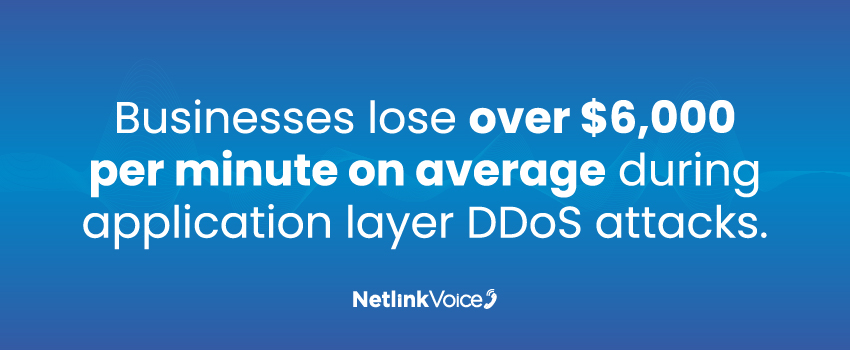
6 Key Challenges Of DDoS Attack Prevention
Several factors make it extremely difficult for businesses to prevent DDoS attacks, including:
Traffic Volume
DDoS attacks generate massive amounts of traffic, often more than hundreds of gigabits per second. This volume can overwhelm even well-provisioned networks and services.
Distributed Nature
DDoS attacks originate from multiple sources at the same time, which makes blocking traffic from a single IP address or location challenging.
Advanced Techniques
Sophisticated attackers use advanced techniques to mimic legitimate traffic and bypass traditional security measures.
Complex Networks
Modern business networks are complex and distributed, which creates more entry points for hackers to exploit.
Fast Evolution
Since DDoS attack techniques are constantly evolving, businesses must continually update their prevention strategies.
Distinguishing Traffic
Separating malicious traffic from legitimate requests can be especially difficult during high-volume attacks.
Adopting a multi-layered approach to preventing DDoS attacks can help your IT team overcome these obstacles and boost your organization’s overall cyber resilience.
DDoS Mitigation Tools & Technologies
Preventing DDoS attacks isn’t just about knowing the risks, you also need the right technology in place. Common solutions include:
Cloud-Based DDoS Protection
Routes traffic through large-scale mitigation networks that absorb and filter attack traffic before it reaches your infrastructure.
On-Premise Appliances
Hardware deployed within your network to detect and block malicious traffic in real time.
Traffic Scrubbing Services
Specialized services that inspect, filter, and return only legitimate traffic to your network.
Content Delivery Networks (CDNs)
Distribute content across multiple servers globally, making it harder for attackers to overwhelm a single location.
Web Application Firewalls (WAFs)
Protect application-layer targets by filtering malicious HTTP/HTTPS requests.
A layered approach, combining these technologies, offers the best defense, since different tools excel at mitigating different types of attacks.
5 Signs You’re Under A DDoS Attack
Early detection can mean the difference between a brief disruption and hours of downtime. Watch for:
- Sudden, unexplained spikes in incoming traffic
- Slow or unresponsive websites and applications
- Increased error rates or timeouts in web services
- Network latency from unusual geographic regions
- Difficulty accessing even simple online resources internally
If you notice multiple signs at once, act immediately, engage your IT security team, alert your ISP, and activate your response plan.
10 Best Practices To Prevent DDoS Attacks
Protecting your business from a DDoS attack doesn’t have to be complicated. Here are 10 best practices you can follow to prevent and mitigate DDoS attacks:
1. Minimize Entry Points
Reducing your attack surface is like closing the doors and windows in your house – it gives attackers fewer ways to get in. Start by implementing network segmentation, which divides your network into smaller, isolated parts. This way, if one area is compromised, the others remain safe.
Next, remove potential entry points by closing any unused ports and removing unused services. Make sure to regularly update all your systems and applications to fix any known vulnerabilities.
You might also consider using a reverse proxy to hide your servers from direct access. This acts as a middleman, making it harder for attackers to target your critical infrastructure directly.
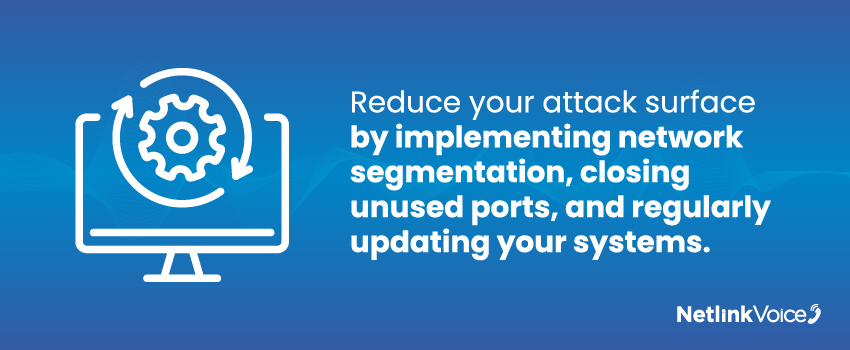
2. Apply Rate Limiting
Rate limiting sets restrictions on how many requests a single user or IP address can make within a certain time frame. This keeps your web servers from getting overwhelmed during a DDoS attack.
One common method is the token bucket algorithm, which allocates a fixed number of ‘tokens’ to each user over time. Each request uses a token, and when tokens are depleted, no more requests are allowed until the allocation refreshes.
More sophisticated techniques use machine learning to adapt these limits based on normal traffic patterns. While rate limiting is powerful, you need to fine-tune it carefully to avoid blocking legitimate users.
3. Know Your Traffic
Understanding your typical traffic patterns is essential for identifying unusual activity. Start by documenting typical traffic volumes, sources, and characteristics to establish a baseline of normal network behavior.
Deploy continuous monitoring tools to keep an eye on your network traffic at all times. These provide detailed information about traffic volume across different protocols, geographic origins of traffic, and server response metrics. You can also set up alert systems for unusual spikes or patterns to warn your IT teams of potential threats.
Since your organization’s traffic patterns will change as your business grows, you’ll need to regularly review and update your baselines and monitoring systems. By knowing what’s normal, you’ll be much better equipped to spot and respond to abnormal traffic that could signal a DDoS attack.
4. Implement Threat Monitoring
Think of threat monitoring as your digital security camera system. It keeps a constant watch on your network to look for signs of suspicious activity. Implement a threat monitoring system by deploying network monitoring tools that can detect traffic anomalies and provide a real-time view of what’s happening on your network.
Next, add intrusion detection and prevention systems (IDS/IPS) to your security setup. These analyze traffic for known attack signatures and suspicious behavior, then alert your team or take automated actions to mitigate attacks as they detect them.
Consider incorporating a security information and event management (SIEM) solution to centralize your security data. SIEM solutions consolidate data from various security sources to make it easier to spot complex attack patterns.
5. Deploy A Web Application Firewall
A Web Application Firewall (WAF) sets up a barrier between your web apps and the internet to filter out harmful traffic before it can reach your servers. This is especially effective against DDoS attacks targeting the application layer.
Modern WAFs use advanced rules and algorithms to differentiate between legitimate and malicious traffic and block known attack patterns, suspicious IP addresses, and unusual behavior. Many WAFs update their rules automatically based on global threat data, helping protect you against new types of attacks as they emerge.
WAFs are also highly customizable. As you discover new threats, you can quickly add new rules to block them.
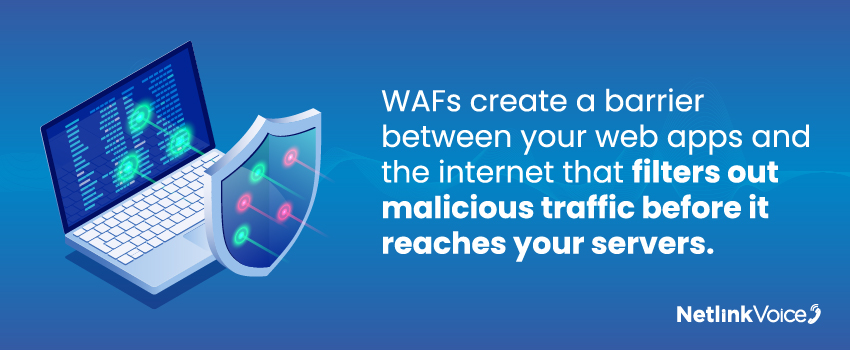
6. Increase Bandwidth
While not a complete solution on its own, adding more bandwidth can increase your network’s capacity to handle traffic surges during an attack. Start by discussing your bandwidth needs and potential DDoS risks with your Internet Service Provider (ISP). Many ISPs offer DDoS protection services that provide extra capacity and filtering capabilities during an attack.
Implementing bandwidth clustering or load balancing across multiple servers can help you distribute incoming requests and prevent any single server from becoming overwhelmed. You can also distribute traffic across several geographic locations using a Content Delivery Network (CDN). CDNs cache your content on servers worldwide and provide it from the nearest location, improving performance and mitigating the damage a DDoS attack can do by spreading traffic across a distributed network.
Remember to conduct regular capacity planning and testing to make sure your infrastructure can handle traffic spikes effectively.
7. Know The Symptoms
Recognizing the signs of a DDoS attack is critical for fast response and mitigation. Key symptoms to watch for include:
- Unusually slow network performance
- Unavailability of a specific website or service
- Inability to access any website from within your network
- A sudden increase in spam emails
- Unexplained internet disconnections
You can help your employees identify these symptoms more effectively by providing security awareness training, establishing baseline performance metrics, and proactively monitoring your network.
8. Monitor & Analyze Log Data
Monitoring and analyzing your system logs regularly can provide valuable insights to help your teams prevent DDoS attacks. Set up automated log analysis tools to detect patterns or activities that might indicate a DDoS attack, and establish a routine for your security team to review log summaries and reports. Pay particular attention to unusual traffic spikes, a high number of requests from a small number of IP addresses, and sudden increases in errors or failed requests.
Your IT staff can use the insights gained from log analysis to refine your organization’s DDoS prevention strategies over time. By studying the characteristics of past attacks or attempts, you can adjust your defenses to better protect against similar threats in the future.
9. Prepare A DDoS Response Plan
Putting together a DDoS response playbook can help reduce disruptions during an attack. Start by defining roles and responsibilities for your incident response team. Designate a response coordinator, identify key technical personnel, and outline communication channels.
Develop step-by-step procedures for identifying and mitigating the different types of DDoS attacks. Include processes for engaging your ISP or managed service provider, implementing traffic filtering or rerouting, and activating backup systems.
Establish communication protocols by outlining how and when to notify stakeholders, including management, customers, and potentially law enforcement. You can also prepare template communications in advance to ensure clear, consistent messaging during future attacks.
Run tabletop exercises and live simulations that mimic actual DDoS conditions to test and refine your response plan, and make sure to update your plan to reflect any changes in your infrastructure or staff.
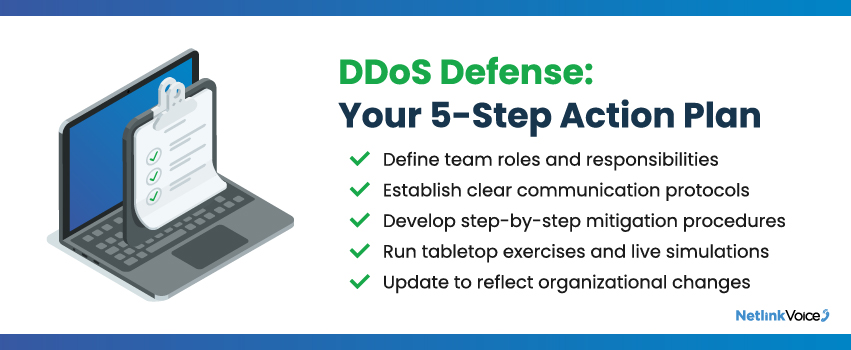
10. Outsource Your DDoS Protection
Teaming up with a managed services provider can be the best DDoS attack prevention strategy for many businesses. These services offer resources and expertise that can be challenging – and expensive – to maintain in-house.
Professional DDoS protection services typically provide:
- 24/7 monitoring and response capabilities
- Access to global networks capable of absorbing large-scale attacks
- Advanced traffic analysis and filtering technologies
- Expertise in the latest DDoS mitigation tools and attack trends
When considering outsourcing, carefully evaluate your potential providers. Make sure they have a proven track record of successfully mitigating large-scale attacks, and consider factors like the size and distribution of their network infrastructure, the range of protection services offered, and their ability to customize solutions to your needs.
Outsourcing can provide a lot of benefits, but you should also maintain some in-house expertise to work effectively with the service provider during an incident. Think of this outsourced protection as an extension of your security team rather than a complete replacement.
Distributed Denial of Service (DDoS) Attacks FAQs
What is the difference between a DoS and a DDoS attack?
A DoS attack originates from a single source, while a DDoS attack comes from multiple compromised devices, making it harder to block.
Can a firewall stop a DDoS attack?
Standard firewalls can block some malicious traffic, but they are not enough for large-scale or sophisticated DDoS attacks. Dedicated DDoS mitigation tools are recommended.
How long can a DDoS attack last?
Attacks can last from minutes to days. Some are short bursts meant to distract IT teams while other malicious activities occur.
Who is most at risk of a DDoS attack?
Any organization with an online presence can be a target, but high-traffic websites, eCommerce platforms, financial services, and gaming companies are frequent victims.
What’s the first thing I should do if I suspect a DDoS attack?
Contact your IT team or security provider, alert your ISP, and activate your pre-defined incident response plan.
Prevent DDoS Attacks With Right-Fit Cybersecurity Solutions
Preventing DDoS attacks isn’t just about keeping your website online; it’s about maintaining customer trust, protecting sensitive data, and continuing business operations without disruption. By implementing DDoS prevention strategies, you can defend against current threats while also future-proofing your network against the ever-changing cybersecurity landscape.
Ready to safeguard your business against DDoS attacks? Netlink Voice can help. We offer comprehensive cybersecurity services to give you peace of mind, including employee security awareness training, simulated phishing campaigns, proactive network monitoring, and more.
Whether you’re struggling with cybersecurity staffing or need advanced SIEM capabilities, our experts are here to help you keep your network, data, and customers protected. Reach out to Netlink Voice today to get started.
Sources:

